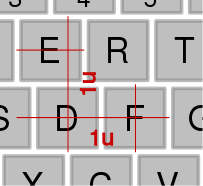Unit
A unit is a measurement of keyboard key width, based on the size of a normal letter key (which is 1 unit tall by 1 unit wide).
Details
One unit is the distance from one key to the next; keycaps are fractionally less than their unit size to allow for gaps between keys. The spacing between single-unit keys is referred to as the key pitch or pitch of the keyboard.
Key sizes are usually in multiples of ½ (0.5) or ¼ (0.25) unit. For instance, a typical space bar for a modern PC keyboard is 6.25 units wide, taking up the same space as six and one quarter one-unit keys.
Note that one unit of height may be different from one unit of width on a keyboard.
Standards
The key spacing unit is exactly defined as the distance between the centres of neighbouring letter keys in the vertical and in the horizontal projection. Normally, but not necessarily, the vertical and the horizontal unit have the same value. The unit value of today has been inherited from American typewriter keyboards of the late 19th century, which happened to have unit values of about ¾ inch. Owing to the market dominance of the American makes, this value made it into European national standards from the 1920s on.[1] Whilst almost all full-size keyboards have unit values of about 19 mm or ¾ inch, there currently is no international standard that specifies it. There used to be ISO 1091,[2] which prescribed unit values of 19 mm ± 1 mm or 0.75" ± 0.04" horizontally and vertically; but this specification was lost in 1994 when the standard was withdrawn in favour of the ISO 9995 series[3]. Today, national standards have been reduced to what is specific to their national layout and otherwise refer to ISO 9995. But since the unit definition is still missing in ISO 9995, German DIN, for instance, keeps it in a preliminary standard, DIN 2137-2,[4] while waiting for this to be ruled by an international standard.
Note that the tolerances do not add. Thus, if the standard sets a unit value of 19 mm ± 1 mm, the distance between the centres of 'Q' and 'P', which are 9 units apart, has to be 171 mm ± 1 mm, not 171 mm ± 9 mm.
Exceptions
Some (not all) models of the Cherry G84 series with Cherry ML switches allegedly have a reduced unit size of about 18 mm; this has, for instance, been measured for a G84-4400, but not for G84-90218, which has a 19 mm unit size.
Gallery
See also
External links
- Ergonomics Made Easy — 'keypitch' definition
References
- ↑ German standard DIN 2111:1927, Tastenabstände – Richtlinien für Neukonstruktionen, which has vertical and horizontal units of 19 mm ± 1 mm.
- ↑ ISO 1091:1977, Typewriters – Layout of printing and function keys. There was a precursor, ISO/R 1091, since 1967.
- ↑ ISO/IEC 9995:1994, Information technology - Keyboard layouts for text and office systems
- ↑ DIN 2137-2:2012, Tastaturen für die Daten- und Texteingabe - Zusätzliche Anforderungen. (Earlier, the unit was defined in separate standards DIN 2112, DIN 2127 and DIN 2139 for mechanical typewriters, electric typewriters and computer keyboards, respectively.)






